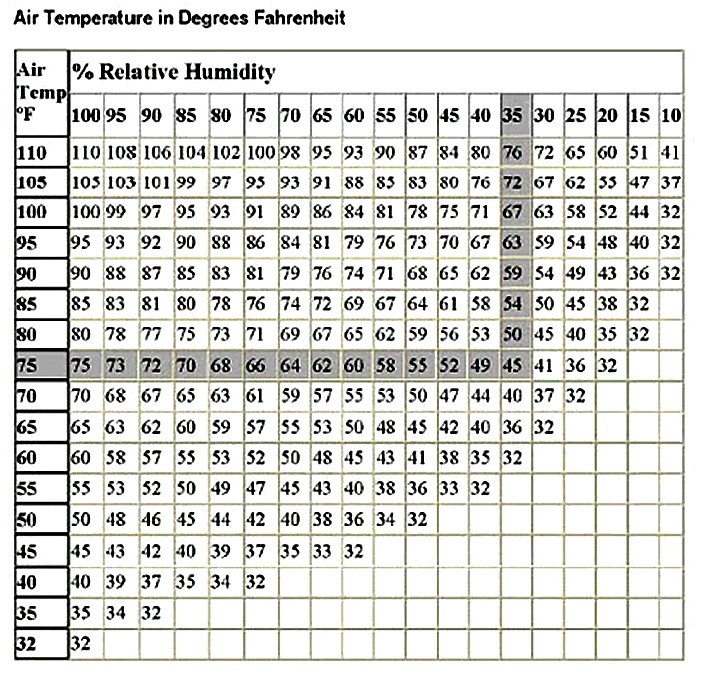Dew point is defined as the atmospheric temperature below which water droplets begin to condense and dew can form. When you put a cold glass in a humid room, condensation forms on the glass. This is because the glass has a temperature below the dew point in the room. The same goes for a floor during a coatings job. If the slab of concrete is at a temperature that is lower than the dew point of the room, condensation will form on the concrete, creating all sorts of issues with your coating such as compromised bond and possible finish issues such as fisheyes and color inconsistencies. Below is a table showing the relationship between temperature, humidity and dew point.
As you can see, if the air temperature is 75 degrees and the relative humidity of the room is 35%, the dew point would be 45 degrees. This means that if your floor temperature is 45 degrees or lower, coating the floor is a risk. This is why most technical data sheets will say not to coat a floor within 5 degrees of the dew point. The concrete slab can contain condensed moisture on the surface, causing adhesion, cure, and film issues. Also, it is worth noting for complete understanding that at 100% humidity, the dew point is equal to the air temperature. This is because when the relative humidity is at 100%, moisture can no longer evaporate into the air because it is completely saturated. For example, in 100% RH, if you put a wet rag outside, even if the temperature is 85 degrees, it will never dry because the air is already completely saturated with moisture and the moisture from the rag has nowhere to go.
A common misconception…
“The weather man says the dew point is 40 degrees today and my slab is 50 degrees, so I’m good to coat.” In some cases, this is correct. If the floor is outside, or in an outside garage, or in new construction with no influence of HVAC, this statement is true. However, the temperature and relative humidity outside is not always the same as inside. The relative humidity and temperature need to be taken in the environment you are coating. If the temperature outside is 60 degrees and the relative humidity is 50%, the dew point would be (according to the chart) 41 degrees. This is the dew point the Weather Channel would have listed. If your slab was 50 degrees, you would be good to coat. However, if you go inside in a temperature controlled environment and now the temperature of the air is 70 degrees with the same 50% RH, suddenly the dew point is 50 degrees and you are at risk with your 50 degree slab. Usually, in a temperature controlled environment the concrete slab has been acclimated to a temperature close to the air temperature and RH is kept at a comfortable level, so dew point is rarely an issue, but it is a common mistake to watch the weather channel and use their outdoor related dew point for a temperature controlled environment.
What do I need to measure the correct dew point where I am coating?
There are many dew point meters on the market and choosing the right one in your price range is up to you. Or, if you use the table above, all you need is an instrument that measures humidity and temperature. Remember to make sure whatever you’re coating is at least 5 degrees above the dew point of the environment you are coating in.
Do you have a flooring project, but don’t know where to start? Our Industrial Flooring Self-Assessment Tool can help you determine the ideal solution for your unique application.


